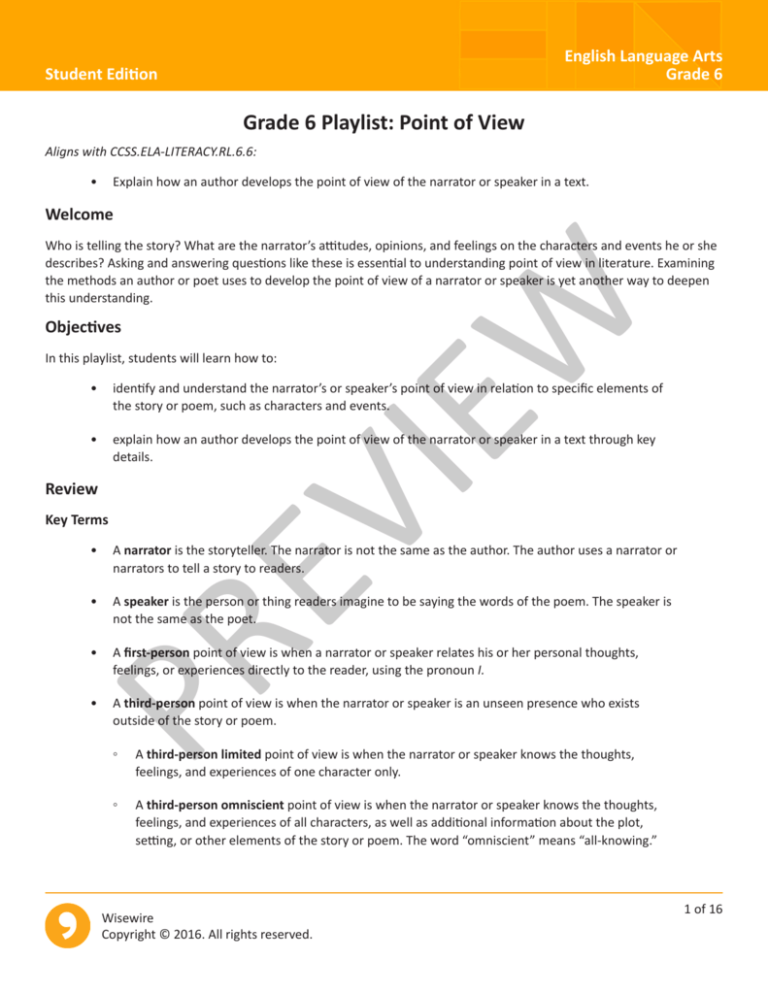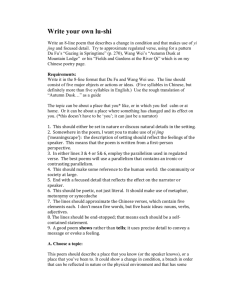
English Language Arts
Grade 6
Student Edition
Grade 6 Playlist: Point of View
Aligns with CCSS.ELA-LITERACY.RL.6.6:
• Explain how an author develops the point of view of the narrator or speaker in a text.
Welcome
Objectives
In this playlist, students will learn how to:
EW
Who is telling the story? What are the narrator’s attitudes, opinions, and feelings on the characters and events he or she
describes? Asking and answering questions like these is essential to understanding point of view in literature. Examining
the methods an author or poet uses to develop the point of view of a narrator or speaker is yet another way to deepen
this understanding.
• identify and understand the narrator’s or speaker’s point of view in relation to specific elements of
the story or poem, such as characters and events.
VI
• explain how an author develops the point of view of the narrator or speaker in a text through key
details.
Review
Key Terms
PR
E
• A narrator is the storyteller. The narrator is not the same as the author. The author uses a narrator or
narrators to tell a story to readers.
• A speaker is the person or thing readers imagine to be saying the words of the poem. The speaker is
not the same as the poet.
• A first-person point of view is when a narrator or speaker relates his or her personal thoughts,
feelings, or experiences directly to the reader, using the pronoun I.
• A third-person point of view is when the narrator or speaker is an unseen presence who exists
outside of the story or poem.
◦◦
A third-person limited point of view is when the narrator or speaker knows the thoughts,
feelings, and experiences of one character only.
◦◦
A third-person omniscient point of view is when the narrator or speaker knows the thoughts,
feelings, and experiences of all characters, as well as additional information about the plot,
setting, or other elements of the story or poem. The word “omniscient” means “all-knowing.”
Wisewire
Copyright © 2016. All rights reserved.
1 of 16
English Language Arts
Grade 6
Student Edition
Practice!
To review how to identify point of view in a story, complete this activity:
• https://www.opened.com/homework/5-rl-6-describe-how-a-narrator-s-or-speaker-s-point-ofview/3689886
Exploring the Standard
A Closer Look: Key Details
EW
Authors develop the point of view of a narrator or speaker in a text in a variety of ways. Key details are an important tool
authors use to develop point of view in stories and poems.
Stories and poems include many key details. Descriptions of characters (including their thoughts, actions, and words),
settings, and events are examples of these details. The details an author chooses to include—or not include—in a story
or poem help to shape the point of view of the narrator or speaker.
Example 1
Listen!
VI
In this selection from Chapter IV from Mark Twain’s The Adventures of Huckleberry Finn, Huck describes how he and his
friend Jim spend their time on an uninhabited island in the Mississippi River. The story is written from the first-person point
of view of Huck, a young Southern boy who has taken refuge on the island to escape from his father, who kidnapped him
and wanted to steal his money. While on the island, Huck runs into Jim, a runaway slave who is also hiding.
Listen to an audio recording of The Adventures of Huckleberry Finn:
PR
E
• https://librivox.org/the-adventures-of-huckleberry-finn-by-mark-twain
Wisewire
Copyright © 2016. All rights reserved.
2 of 16
English Language Arts
Grade 6
Teacher Edition
Teaching Notes: Point of View
The goal of RL.6.6 is for students to understand and be able to explain how authors use various literary techniques to
develop the narrator’s or speaker’s point of view in stories or poems. The following information contains ideas that
teachers can incorporate into their classroom as well as additional resources to peruse and integrate into instruction
as appropriate.
Activities
EW
1. Select an excerpt from The Adventures of Tom Sawyer, and have students complete a Venn diagram comparing and contrasting how Mark Twain develops the point of view in The Adventures of Huckleberry Finn and
The Adventures in Tom Sawyer. Have students work with a partner to create a short presentation comparing
and contrasting the author’s development of point of view in each text. Invite students to share their presentations with the class.
2. Direct students to conduct research, finding two poems with a similar topic or theme but different points
of view. Divide the class into groups of four or five, asking students to discuss how the poet developed the
point of view of each speaker in each poem. Remind students to focus on how the key details in the poem
contributed to the development of the point of view.
VI
Writing Prompts
1. Assign students a grade-appropriate excerpt from a fictional text with a distinct point of view and direct students to answer the following question in an essay: How does the author develop the point of view? Support
your answer with at least two examples from the text.
PR
E
2. Ask students to think about how developing a third-person limited and third-person omniscient point of view
are similar, and how they are different. Have students write a short essay explaining their thoughts. Instruct
students use at least two different short stories, novels, or poems in their explanation.
Additional Resources
Consider these additional resources when teaching RL.6.6:
“Mark Twain’s Huckleberry Finn: Controversy at the Heart of a Classic”: This resource provides teachers with ways to
talk about the degrading language used in The Adventures of Huckleberry Finn.
• http://blogs.loc.gov/teachers/2013/11/mark-twains-huckleberry-finn-controversy-at-the-heart-of-aclassic/
“Act it Out! True Story of the Three Little Pigs Builds Understanding of Point of View (Virtual Tour)”: This resource
educates teachers about introducing the idea of point of view through comparison.
• http://www.oise.utoronto.ca/balancedliteracydiet/Recipe/50362/
• https://www.youtube.com/watch?v=42r4vpgGVgg
Wisewire
Copyright © 2016. All rights reserved.
1 of 15








